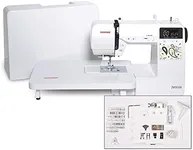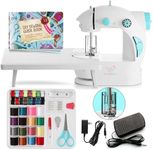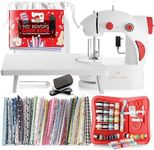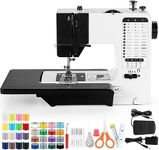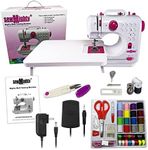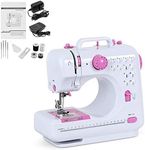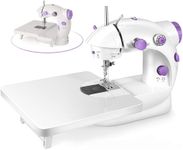Buying Guide for the Best Kids Sewing Machines
Choosing a sewing machine for kids is all about finding a balance between safety, ease of use, and features that will help them learn and enjoy sewing. The right machine should be simple enough for a child to operate, but also sturdy and reliable so it can handle their creative projects. When shopping, focus on machines that are designed with young users in mind, and consider how the features will match your child's age, skill level, and interests.Safety FeaturesSafety features are crucial in kids' sewing machines because they help prevent accidents and injuries. Look for things like finger guards, speed control, and automatic needle stops. Machines with these features are better suited for beginners and younger children, as they reduce the risk of getting hurt. If your child is very young or just starting out, prioritize machines with more built-in safety measures. Older or more experienced kids may be able to handle machines with fewer safety features, but it's always better to err on the side of caution.
Ease of UseEase of use refers to how simple the machine is to operate, including threading the needle, winding the bobbin, and selecting stitches. For kids, a machine with straightforward controls and clear instructions is best. Some machines have color-coded guides or automatic threading, which can make learning less frustrating. If your child is a complete beginner, choose a machine with the simplest setup. If they have some experience, a slightly more advanced machine with a few extra features can help them grow their skills.
Stitch OptionsStitch options are the different types of stitches a sewing machine can make, such as straight, zigzag, or decorative stitches. For kids, too many options can be overwhelming, so a machine with a handful of basic stitches is usually enough. Beginners will do well with just straight and zigzag stitches, while more advanced young sewers might enjoy having a few decorative stitches to experiment with. Think about your child's interest and skill level when deciding how many stitch options are appropriate.
Size and WeightThe size and weight of a sewing machine affect how easy it is for a child to move and use it. Lightweight and compact machines are easier for kids to handle and store, but they should still be sturdy enough not to tip over during use. If your child will be sewing at a table or moving the machine around, a smaller, lighter model is ideal. For older kids or those who will keep the machine in one place, a slightly heavier machine can offer more stability.
DurabilityDurability means how well the machine can withstand regular use and the occasional bump or drop. Kids can be rough on their belongings, so a sewing machine made from strong materials and with solid construction will last longer and perform better. If your child is likely to use the machine often or for bigger projects, prioritize durability. For occasional or supervised use, a less robust machine may be sufficient.
Power SourceSome kids' sewing machines run on batteries, while others plug into the wall. Battery-powered machines are more portable and can be used anywhere, but they may not be as powerful or consistent as electric models. Plug-in machines usually offer more reliable performance but need to be used near an outlet. If your child will be sewing in different locations or you want the convenience of portability, a battery-powered machine is a good choice. For more regular use at home, a plug-in model may be better.
